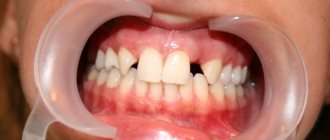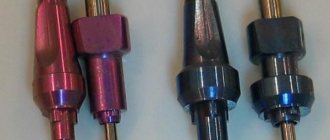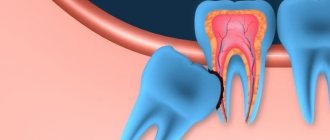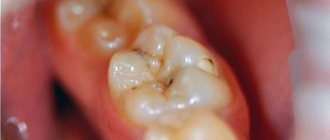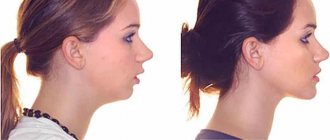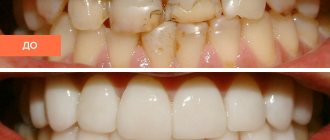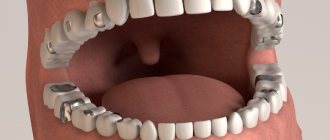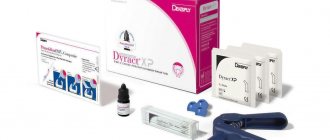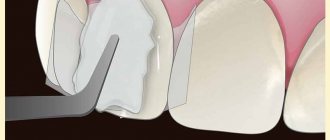A beautiful smile is the key to the health and success of a modern person. If people smile widely and openly, then those around them are more inclined to like them. Any deficiencies and health problems immediately affect the quality of life, so the problem of cosmetic dental restoration worries many today.
With the help of dental treatment and restoration, you can put in order and restore teeth damaged by caries and other dental diseases. Correctly selected material, shape and color will help to hide any imperfections of the teeth as much as possible and restore them to their original appearance.
Restored teeth after such restoration cannot be distinguished from healthy neighboring teeth. It is prescribed in case of irregularly shaped teeth, chips, cracks and spaces between teeth, as well as after dental trauma. The restoration easily changes the length or width and aligns the dentition. Pigment spots or stains from coffee and smoking can also be removed with cosmetic restoration.
Types of modern prostheses
By level of amputation:
- cosmetic finger prostheses;
- prosthetic part of the hand;
- full hand prosthesis;
- forearm prosthesis (up to the elbow);
- shoulder prosthesis;
- prosthesis after disarticulation of the shoulder joint.
According to the method of attachment to the limb stump:
- using a silicone case and lock;
- using the anatomical shape of the receiving sleeve;
- using belts (bandage).
According to their intended purpose, there are two groups of prostheses:
- cosmetic - imitate a natural hand, hiding the defect;
- functional - make it possible to use the injured limb.
According to the mechanism of action, functional prostheses are:
- bionic (myoelectric or bioelectric);
- workers (passive);
- traction (active mechanical).
How does the butterfly installation procedure work?
Installing a cosmetic case has many similarities to installing permanent dentures, but will take less time. No more than 2-3 visits to the dental office will be required. The whole process can be divided into several stages:
- Initial dental examination. The specialist will examine the oral cavity, select the shape and type of prosthesis, choose treatment tactics, and give recommendations.
- Taking an impression of the jaw. It is carried out before the tooth is removed. This will allow the specialist to subsequently reproduce the anatomical shape of the tooth being replaced as accurately as possible. If the tooth is missing, you will need to take a picture.
- Creating an immediate construction.
- Removal of problem teeth.
- Trying on the finished product. If the patient does not experience discomfort, then the orthopedist will install the “cosmetic bag” in place.
- Correction. It is carried out if the patient experiences discomfort after installing the product.
Bionic prostheses
The most advanced prostheses, as close as possible to the action of the human hand. To operate, they use an external energy source (rechargeable batteries), are equipped with electric motors and are controlled by electrical signals from the patient’s body. Myoelectric prostheses respond to muscle contraction. Changes in the electrical potential are detected by EMG sensors in the prosthetic socket. They transmit a signal to the microprocessor of the artificial hand, and the prosthesis performs a certain action.
Note!
- Conventional bioelectric prostheses make grip a breeze. This is the basic movement, but it is not always enough.
- Highly functional prosthetics can accommodate a variety of grips. For this, two myodensors are used that sense the activity of the two largest muscles of the arm. To select the desired gesture, the patient sends the prosthesis several sequentially repeated commands - they serve to switch modes by brute force. After training, the prosthesis becomes a real extension of the hand; the person uses it instinctively, performing different types of grips without thinking.
Bionic hand prostheses improve the quality of life of patients. People become able to perform complex activities such as drawing, working with a keyboard, tying shoelaces, cooking and many others. The latest generation of bionic prostheses are capable of performing finger movements. For example, the Touch Bionic hand from Ossur performs functionality close to the actions of a real hand, since each finger is equipped with a separate electric motor. The patient can choose from twelve hand grip options. Your prosthetic technician can help you determine your individual reaction speed and grip strength. This allows you to comfortably work even with very fragile objects, for example, taking a chicken egg.
Pros:
innovative technological appearance, use for all main types of household activities.
Minuses:
high cost, unnatural appearance.
Dangers of toothless life
Which of us is unfamiliar with the expression “eats so much that it’s cracking behind the ears”? But a person with partial or complete loss of teeth can hardly boast of “crackling sounds behind the ears” while eating. He has to exclude hard food from his diet, or swallow it after barely chewing it. And as you know, food, when crushed, begins to be digested in the mouth, but with large pieces the stomach will have to cope with triple strength. The already mentioned “crackling behind the ears” is due to the fact that the salivary glands are located in the parotid region. It is they who produce the production of a very important hormone that is involved in the regulation of calcium metabolism; in addition, it affects the blood coagulation and anticoagulation systems, the metabolic processes of the liver, stomach and other vital organs. With partial or complete absence of teeth, chewing movements of the lower jaw are limited, which invariably leads to dysfunction of the salivary glands. This is where changes in the composition of the blood and sudden gastric and liver dysfunctions appear. And a violation of calcium metabolism in the body, among other things, will undoubtedly have a negative “echo” on the remaining teeth. In addition, a person who is missing one or more teeth suffers from the inability to smile broadly, laugh, or conduct a normal conversation, which can negatively affect his communication with others and lead to stress. If this happens, the conclusion is clear - dental prosthetics is simply necessary for a person to continue a normal life.
Working dentures
A working prosthesis is not at all like a regular hand. It is equipped with an adapter for installing various attachments, which allows you to actively use the upper limb for work. Attachments for writing, cutlery, drawing, printing, and sewing can be attached to the prosthesis. There are grips for hammers, keys, scissors and other tools.
Pros:
inexpensive design, great functionality.
Minuses:
unnatural appearance, the need to purchase attachments for each type of activity and change them during work.
Teeth on a plate
Complete removable plate dentures
Modern plate prostheses have not changed much structurally, but have stepped far forward in aesthetics.
The base plate is now not just pink, but with introduced capillary vessels, which creates a very natural appearance of the mucous membrane, and artificial teeth, made using modern technologies, have an excellent appearance and high wear resistance. All this contributes to achieving an individual aesthetic effect and reliability of the prosthesis design. A complete plate denture is the only option to replace all lost teeth (if you do not take into account dental implantation). It is held in the mouth by the suction effect and the anatomical features of the jaws. There is one nuance here - the difference between holding the denture on the upper and lower jaw. The large support area, hard palate and structure of the upper jaw contribute to good fixation of the prosthesis. The same cannot be said about the lower jaw. A small support area, a large number of movable and elastic frenulums and folds do not allow the prosthesis to adhere normally. And the very “glib” language makes this task even more difficult to accomplish. For the toothless lower jaw, the patient can be offered a so-called “floating” removable denture, which will float and not sit tightly in place. It takes a long time to get used to it, but to speed up the process, special fixing creams are used. “Pleasure” is, of course, not very pleasant, so you shouldn’t bring it closer. In the lower jaw, you have to fight for every tooth. Fixation of the prosthesis is always better when there is support. A partial plate denture
is used when one or more teeth are missing. It is made entirely of plastic, with the exception of metal clasps (hooks). The prosthesis is light and cheap, it does not take up much space in the mouth, and rests entirely on the gum. It can be simply irreplaceable for temporary prosthetics.
Active mechanical prostheses
Active (or “traction”) - allow the artificial hand to compress, due to traction, to hold various objects. The action occurs using mechanical traction (when the opposite shoulder moves, the cable is tightened or loosened). A simple and reliable mechanism allows you to control the strength and speed of your grip.
With enough practice, a person masters fairly subtle movements: he can write with a pen, use cutlery, type, carry a bag, light matches.
Traction prostheses can be installed in children from 8 years of age. Constant training of the muscles of the shoulder and forearm subsequently helps to form a stump and quickly get used to a more advanced bionic prosthesis.
Pros:
simple mechanism, easy to maintain, precise movements when performing some delicate work.
Minuses:
the use of a traction band (can rub), the need to be careful with the prosthesis shell and periodically replace it.
Your new smile is our concern
For prosthetics, specialists from the CELT Dentistry Department use ultra-thin imported ceramics, which allows for maximum preservation of tooth tissue, as well as removable dentures with invisible micro-locks. In case of complete or partial absence of teeth, frameless ceramic, metal-ceramic and solid-cast crowns are made. Fixed (bridge) and removable (clasp and plate) prostheses are performed. We can prepare for prosthetics, remove the nerve and fill the canal. If necessary, X-rays can be taken in our Center, in the radiology department, which will allow you to significantly save time. All crowns are selected exactly to match the color of real teeth, for which we have a special color shade scale at our disposal. The department also has its own dental laboratory, equipped with the latest equipment (6 highly qualified dental technicians on staff), which allows us to produce crowns or dentures in a fairly short time, thereby saving your time. Come! You will leave us smiling broadly!
Cosmetic dentures
A cosmetic prosthesis is as close as possible to the natural appearance of a real hand, but is completely non-functional. You won’t be able to do anything complicated with it (for example, buttoning a jacket). The prosthesis consists of four parts: a stump, a supporting socket, a hand frame and a shell (glove). The shell is made of PVC or silicone, matching the patient's skin tone. For greater reliability, images of moles, veins, folds, and palm lines can be applied. It is possible to make a prosthesis with acrylic nails that are as close as possible to real ones.
Pros:
relatively low price, imitates a healthy hand, the hand looks natural - does not attract the attention of others.
Minuses:
the inability to perform any actions, the need to take care of the prosthesis shell and periodically replace it.
Don't be afraid to “put your teeth on the shelf”
Removable prosthetics
- Cost: 33,000 rub.
More details
Dental prosthetics makes it possible to restore teeth that have been removed or lost as a result of illness or injury. Modern dentistry and new technologies for dental prosthetics make it possible to quickly and accurately select the required size, shape and color of new teeth to achieve a high cosmetic effect. Nowadays, dental prosthetics is no longer a long and painful process. Modern removable dentures are fundamentally different from the old ones that our grandparents used. The differences between modern prostheses are new, durable, flexible and safe materials, as well as high technologies that allow us to produce the most suitable prosthesis with maximum precision. There are several methods for restoring lost teeth and normalizing chewing function, that is, normal chewing of food. In this article we will talk about one of the types of dental prosthetics - removable dentures. Such dentures are divided into complete removable and partially removable. They can be lamellar or clasp. Despite the prejudices of many people, removable dentures remain the most common type of prosthetics today, since this method is accessible to most and has the fewest contraindications.
Prosthetic options for missing teeth
Immediate prosthesis Butterfly for 1 tooth
Single removable prosthesis Butterfly is made of plastic or nylon. Equipped with an artificial gum and crown, it is attached using hooks to adjacent teeth on both sides of the defect.
It is used to quickly fill a defect after tooth extraction; it is produced within 1-2 days. Used as a temporary option before permanent prosthetics.
Pros : fast production, instant restoration of row integrity, the most affordable price.
Disadvantages - an immediate denture often breaks, falls out, is not resistant to stress, and stands out against the background of your own teeth.
Dental bridge
In case of a single defect in a row, permanent prosthetics can be offered.
A dental bridge is an orthopedic device for 3 crowns. The central one fills the defect, and the lateral ones serve to attach the structure to the supporting teeth on both sides of the void. They are pre-prepared (sharpened, depulped, reinforced with inlays) in order to prolong the life of the system and prevent the need to remove the bridge in case of caries damage to the supports.
Pros : quick results, aesthetics, price.
The downside is an increase in the load on the supports and progression of atrophy under the hinged crown. As a result, the lateral teeth become loose, which leads to the expansion of the defect.
Implant with crown
Elimination of a single defect by implantation is considered the best method for row reconstruction.
The method involves replacing the root part of the tooth with an implant to install an artificial crown. The implant transfers the chewing load to the bone, which prevents its atrophy. When installing an implant, there is no need to grind down the lateral units. Accordingly, the patient’s own teeth last longer.
Pros : physiological, lifelong results.
Disadvantages : there are contraindications for surgery.

